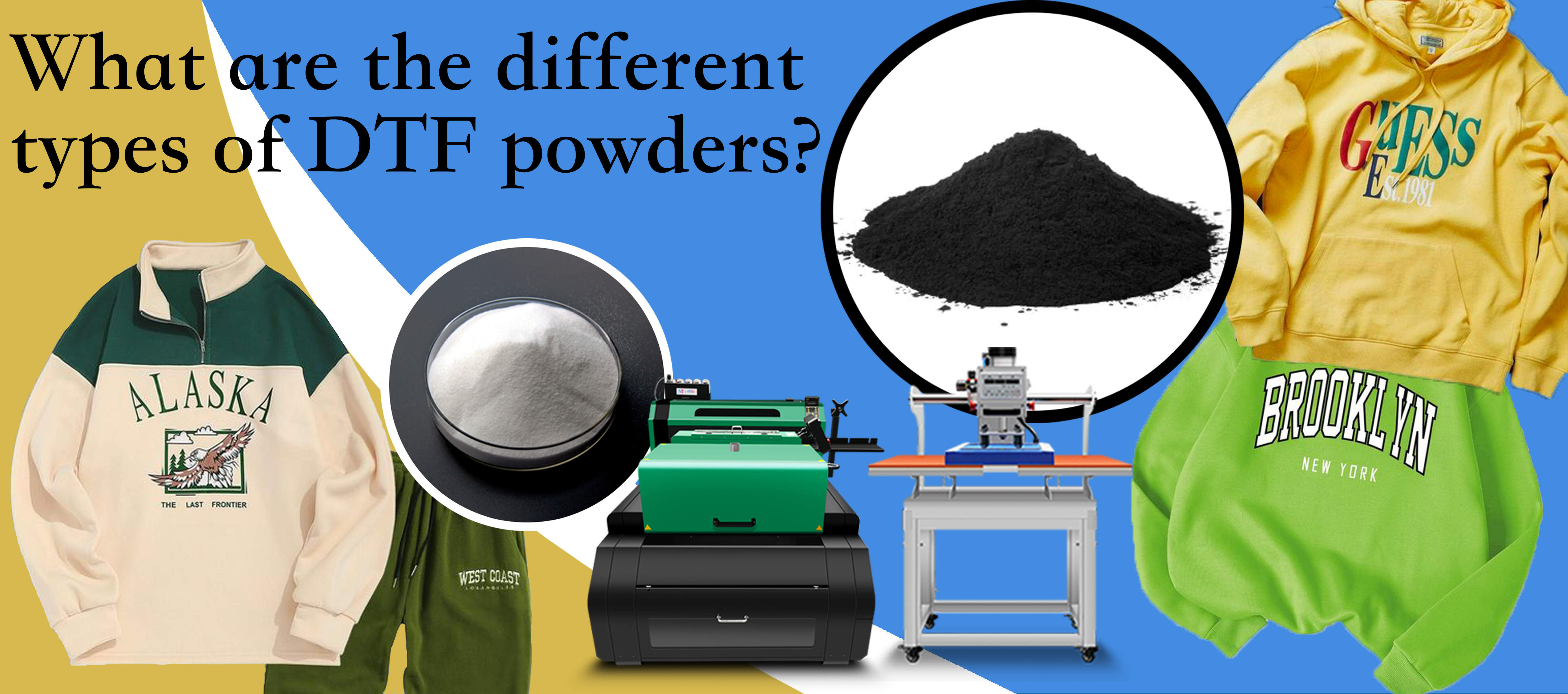
What are the different types of DTF powders?
Hot melt powder is an indispensable material in DTF transfer technology. It provides a unique application process to apply powder directly to the film or substrate. DTF powder is known for its versatility and ability to adhere well to a variety of surfaces, making it a popular choice for creating vibrant and long-lasting prints. According to the composition and performance, it can be divided into PA hot melt powder, PES hot melt powder, EVA hot melt powder, TPU hot melt powder, etc. TPU powder is widely used in DTF transfer process, and white and black powder can be seen on the market.
The decision between black and white DTF powder depends on the application and fabric color. The black DTF powder is excellent at preventing sublimation on dark textiles, while the white DTF powder is adaptable and suitable for any fabric color.
Both white and black powders are available in different thicknesses:
DTF fine powder
Fine powder is defined as 0~70 micron particle size (such as flour)
Features: Suitable for powder coating of small characters. The feel is good, but the fastness is poor. When the air humidity is high, powder can easily stick to the blank areas of the printing film.
DTF medium powder
Medium powder refers to a particle size of 70~170 microns (such as table salt)
Features: The particle shape is obvious, but currently 85% of customers use medium powder because this powder is easier to shake and clean than fine powder. And it feels better than coarse powder.
DTF coarse powder
The particle size of meal is defined as 120-240 microns (like sugar)
Characteristics of DTF coarse powder
The gap is large, the shake powder is clean, and the three-dimensional effect is good (it is recommended to use coarse powder when the summer is humid, or coarse powder can be used when the customer requires a three-dimensional effect).
The difference between white powder and black powder
White powder is suitable for clothes of any fabric color, but white or light-colored clothes are generally used.
Black powder is mainly composed of TPU rubber powder and activated carbon. More suitable for black or dark-colored clothes. It has anti-sublimation function and is commonly used in polyester, luggage and other fabrics.
Our soft and stretchy DTF powder has a better feel than traditional vinyl or other types of heat transfer materials. It's stretchy and soft to the touch.
To put it simply, black powder has a better covering effect on base colors and is easier to cover some bright colors, while white powder has a relatively poor covering effect, but most colors are suitable for white powder.
Hot melt powder is used for printing on various textiles, leather, paper, wood and other materials and for preparing various glues. The glue produced has the characteristics of water resistance, good fastness, fast drying speed, not easy to block the network, and does not affect the color of the ink. It is a new type of environmentally friendly material.
How long does it take for DTF powder to cure?
Many variables, including the type of DTF powder used, the fabric it is printed on, and the curing environment, can affect the cure time of DTF powder.
In general, heat is necessary for effective curing of DTF powders. In order to ensure that the powder adheres properly and forms a lasting print, after the pattern is printed on the film and transferred to the fabric using a heat press, the fabric must be cured at a predetermined temperature for a certain period of time.
Typical drying time for DTF powder is 30 to 2 minutes, and typical curing temperature is 320 to 340 degrees Fahrenheit (160 to 170 degrees Celsius). The specific powder type you are using and the type of fabric you are printing on will affect curing time and temperature.
To ensure your prints are strong and long-lasting, it's critical to follow the manufacturer's curing guidelines. After curing, it is recommended to wash the cloth to confirm that the powder has fully bonded and to remove excess powder from the surface of the fabric.
In summary, DTF powder is a flexible and powerful printing material that is transforming the textile printing industry. Printing with powdered DTF has long been a popular choice among companies and hobbyists alike because of its ability to produce high-quality, long-lasting prints on both light and dark textiles.
The polyester resin content of the DTF powder and whether it needs to be sufficiently cured after application to fabric are important considerations. Additionally, powder DTF printing has multiple stages including design generation, powder application, transfer to fabric, and curing.
While powder-based DTF printing offers many advantages, it also has some disadvantages, such as the potential for powder dispersion and the need for specialized equipment. However, printing with powdered DTF can provide excellent results and be a successful addition to printing companies with the right training and tools.




